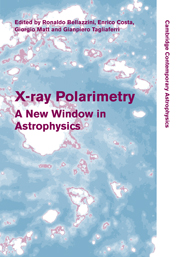Book contents
- Frontmatter
- Contents
- List of contributors
- Preface
- 1 X-ray polarimetry: historical remarks and other considerations
- Part I Polarimetry techniques
- Part II Polarized emission in X-ray sources
- 14 Probing strong gravity effects with X-ray polarimetry
- 15 X-ray polarization from black holes in the thermal state
- 16 Strong-gravity effects acting on polarization from orbiting spots
- 17 Polarization of thermal emission from accreting black holes
- 18 X-ray polarimetry and radio-quiet AGN
- 19 The soft X-ray polarization in obscured AGN
- 20 The polarization of complex X-ray sources
- 21 Polarization of Compton X-rays from jets in AGN
- 22 Polarization of X-ray lines from galaxy clusters and elliptical galaxies
- 23 Polarization characteristics of rotation-powered pulsars
- 24 Polarized X-rays from magnetized neutron stars
- 25 Polarization properties of X-ray millisecond pulsars
- 26 X-ray polarization signatures of neutron stars
- 27 Polarization from the oscillating magnetized accretion torus
- 28 X-ray polarization from accreting white dwarfs and associated systems
- 29 Polarization of pulsar wind nebulae
- 30 X-ray polarization of gamma-ray bursts
- 31 Central engine afterglow from GRBs and the polarization signature
- 32 GRB afterglow polarimetry past, present and future
- 33 Gamma-ray polarimetry with SPI
- 34 INTEGRAL/IBIS observations of the Crab nebula and GRB 041219A polarization
- 35 Fermi results on the origin of high-energy emission in pulsars
- 36 Diagnostics of the evolution of spiral galaxies in a cluster environment
- Part III Future missions
- Author index
- Subject index
36 - Diagnostics of the evolution of spiral galaxies in a cluster environment
from Part II - Polarized emission in X-ray sources
Published online by Cambridge University Press: 06 July 2010
- Frontmatter
- Contents
- List of contributors
- Preface
- 1 X-ray polarimetry: historical remarks and other considerations
- Part I Polarimetry techniques
- Part II Polarized emission in X-ray sources
- 14 Probing strong gravity effects with X-ray polarimetry
- 15 X-ray polarization from black holes in the thermal state
- 16 Strong-gravity effects acting on polarization from orbiting spots
- 17 Polarization of thermal emission from accreting black holes
- 18 X-ray polarimetry and radio-quiet AGN
- 19 The soft X-ray polarization in obscured AGN
- 20 The polarization of complex X-ray sources
- 21 Polarization of Compton X-rays from jets in AGN
- 22 Polarization of X-ray lines from galaxy clusters and elliptical galaxies
- 23 Polarization characteristics of rotation-powered pulsars
- 24 Polarized X-rays from magnetized neutron stars
- 25 Polarization properties of X-ray millisecond pulsars
- 26 X-ray polarization signatures of neutron stars
- 27 Polarization from the oscillating magnetized accretion torus
- 28 X-ray polarization from accreting white dwarfs and associated systems
- 29 Polarization of pulsar wind nebulae
- 30 X-ray polarization of gamma-ray bursts
- 31 Central engine afterglow from GRBs and the polarization signature
- 32 GRB afterglow polarimetry past, present and future
- 33 Gamma-ray polarimetry with SPI
- 34 INTEGRAL/IBIS observations of the Crab nebula and GRB 041219A polarization
- 35 Fermi results on the origin of high-energy emission in pulsars
- 36 Diagnostics of the evolution of spiral galaxies in a cluster environment
- Part III Future missions
- Author index
- Subject index
Summary
We present X-ray and radio polarimetric observations of selected Virgo Cluster spiral galaxies. The X-ray extended emission traces hot-gas filaments in galactic halos and is sensitive to the environmental effects exerted by interactions inside the cluster, like ram-pressure stripping. The radio polarization studies provide clues about alignment, distortion, compression and strength of detected magnetic fields. When used together, the two types of observations constitute an excellent tool for examining disturbances in galactic disks and halos caused by interactions of galaxies with the intracluster medium or between the galaxies themselves. The coming of age of X-ray polarimetry could provide us with unprecedented tools to explore further the evolution of galaxies in a cluster environment.
Introduction
There are a number of environmental effects in clusters of galaxies that modify spiral galaxies causing their HI deficiency, Hα spatial truncation and distortions, as well as strong dynamical and morphological evolution[1]. They influence also galactic magnetic fields, which can be stretched and compressed while the distribution of the ISM is being changed. The Virgo Cluster is the best system to study such processes due to its proximity and large spiral galaxy content. In this work we investigate galaxy–galaxy and galaxy–ICM interactions in the Virgo Cluster in the radio and in the soft X-ray bands. We make use of the VLA and Effelsberg 100-m radio telescope to obtain high sensitivity for the extended total power and polarized nonthermal radio emission.
- Type
- Chapter
- Information
- X-ray PolarimetryA New Window in Astrophysics, pp. 243 - 248Publisher: Cambridge University PressPrint publication year: 2010



